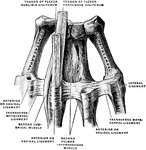Clipart tagged: ‘phalange’
Arm Bones
"The bones of the arm. a, humerus; b, ulna; c, radius; d, the carpus; e, the fifth metacarpal; f, the…
Metacarpal and Phalanges of Finger
Metacarpal bones and first phalanges of the third finger of the right hand, with ligaments, from the…

Side View of Bones in Foot
"The Foot is that part of the lower extremity below the leg on which we stand and walk. It is composed…

Side View of Bones in Foot
"The Foot is that part of the lower extremity below the leg on which we stand and walk. It is composed…

Bones of the Hand
Metacarpal bones and first phalanges of the second to the fifth of the right hand, with ligaments, from…

Phalanges of a Horse
Posterior view of phalanges of a horse disarticulated. Labels: a, os suffraginis; b, os coronae; C,…

Vulture Skeleton
"Skeleton of Egyptian Vulture. (Neophron percnopterus), to show bones of bird. a, post-orbital process;…